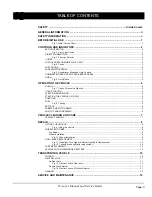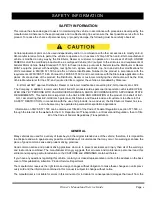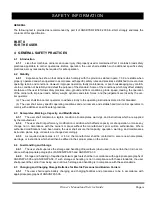
Owner’s Manual and Service Guide
Page xii
S A F E T Y I N F O R M AT I O N
then enter squarely after the elevator car is properly leveled. Once on the elevator, neutralize the controls, shut off
power, and set parking brakes. It is advisable that all other personnel leave the elevator before a carrier is allowed to
enter or exit.
5.5.13
Avoid running over loose objects, potholes, and bumps.
5.5.14
To negotiate turns, reduce speed to improve stability, then turn hand steering wheel or tiller in a smooth,
sweeping motion.
5.6
Loading
5.6.1
Handle only stable and safely arranged loads. When handling off-center loads which cannot be centered,
operate with extra caution.
5.6.2
Handle only loads within the capacity of the carrier as specified on the nameplate.
5.6.3
Handle loads exceeding the dimensions used to establish carrier capacity with extra caution. Stability and
maneuverability may be adversely affected.
5.7
Operator Care of Personnel and Burden Carriers
5.7.1
At the beginning of each shift during which the carrier will be used, the operator shall check the carrier con-
dition and inspect the tires, warning devices, lights, battery(s), speed and directional controllers, brakes, and steering
mechanism. If the carrier is found to be in need of repair, or in any way unsafe, the matter shall be reported immedi-
ately to the designated authority and the carrier shall not be operated until it has been restored to safe operating condi-
tion.
5.7.2
If during operation the carrier becomes unsafe in any way, the matter shall be reported immediately to the
designated authority, and the carrier shall not be operated until it has been restored to safe operating condition.
5.7.3
Do not make repairs or adjustments unless specifically authorized to do so.
5.7.4
The engine shall be stopped and the operator shall leave the carrier while refueling.
5.7.5
Spillage of oil or fuel shall be carefully and completely absorbed or evaporated and fuel tank cap replaced
before starting engine.
5.7.6
Do not operate a carrier with a leak in the fuel system or battery(s).
5.7.7
Do not use open flames for checking electrolyte level in storage battery(s) or liquid level in fuel tanks.
6 MAINTENANCE PRACTICES
6.1
Introduction
6.1.1
Carriers may become hazardous if maintenance is neglected. Therefore, maintenance facilities, trained per-
sonnel, and procedures shall be provided. Such facilities may be on or off the premises.
6.2
Maintenance Procedures
6.2.1
Maintenance and inspection of all carriers shall be performed in conformance with the manufacturer’s rec-
ommendations and the following practices.
(a) A scheduled preventive maintenance, lubrication, and inspection system shall be followed.
(b) Only qualified and authorized personnel shall be permitted to maintain, repair, adjust, and inspect carriers.
(c) Before undertaking maintenance or repair, follow the manufacturer’s recommendations for immobilizing the car-
rier.
(d) Block chassis before working underneath it.
(e) Before disconnecting any part of the engine fuel system of a gasoline or diesel powered carrier with gravity feed
Summary of Contents for 605584-DK
Page 10: ...Owner s Manual and Service Guide Notes Page viii SAFETY INFORMATION ...
Page 16: ...Owner s Manual and Service Guide Notes Page xiv SAFETY INFORMATION ...
Page 45: ...Page 25 GENERAL SPECIFICATIONS Owner s Manual and Service Guide GENERAL SPECIFICATIONS ...
Page 54: ...Page 34 Owner s Manual and Service Guide GENERAL SPECIFICATIONS Notes ...
Page 55: ...Page 35 Owner s Manual and Service Guide VEHICLE WARRANTIES VEHICLE WARRANTIES ...
Page 61: ...Appendix A 1 Owner s Manual and Service Guide LABELS AND PICTOGRAMS LABELS AND PICTOGRAMS ...
Page 68: ......
Page 70: ...Appendix B 2 DECLARATION OF CONFORMITY Owner s Manual and Service Guide ...
Page 71: ...Appendix B 3 DECLARATION OF CONFORMITY Owner s Manual and Service Guide ...
Page 72: ...Appendix B 4 DECLARATION OF CONFORMITY Owner s Manual and Service Guide Notes ...
Page 74: ......































